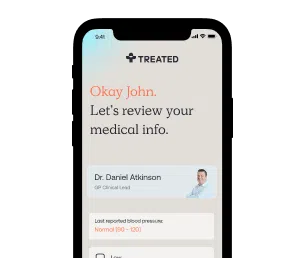Vitiligo
Treatments for pale patches of skin.
Vitiligo doesn’t cause physical pain, but it can affect your self-esteem. If you’re struggling with vitiligo, there are treatments that can help improve your confidence.
Answer some questions about your health and get treatment recommendations from our experts. Order vitiligo treatment online and get it when you need it.
Vitiligo (pronounced vi·tuh·lie·go) is a skin condition characterised by white patches on your skin. It’s classified as an autoimmune disorder, but genetic and environmental factors can contribute to its development. Around 0.5-2% of the world population are thought to have vitiligo, and it can affect all ages, genders and ethnicities. (Although it will be more apparent in those with a darker complexion.)
Vitiligo isn’t contagious, and doesn’t usually cause any health problems.
It also isn't painful, but it can have emotional or psychological effects. This is when getting treatment can be beneficial. Currently, there is no actual cure for vitiligo, so treatments often include restoring lost skin colour or stopping it from spreading to unaffected areas of your body.
There are other conditions that can have the same visual characteristics as vitiligo. Pityriasis alba is another depigmenting skin condition, but its cause is different. It’s important to differentiate between vitiligo and other skin conditions because they need to be treated differently.
Vitiligo is a condition with no one cause, which can happen to anyone at any time. It can affect people of all ages, but it's more common to develop patches before the age of 20.
Here are some factors that can play a role in its onset:
There are two main types of vitiligo: segmental (SV) and non-segmental (NSV).
Segmental vitiligo only affects one area on one side of the body and is less common than other types. The most common SV is uni-segmental, which is characterised by colour loss on one area of the body that spreads very quickly, but only for 6-12 months before stopping.
Non-segmental vitiligo is the more common type of vitiligo. It can occur on the face, neck, arms and scalp and can be symmetrical on both sides of the body. NSV is commonly caused by autoimmune loss of melanocytes. Results of one study show, approximately 83% of patients who had NSV had an autoimmune condition.

How we source info.
When we present you with stats, data, opinion or a consensus, we’ll tell you where this came from. And we’ll only present data as clinically reliable if it’s come from a reputable source, such as a state or government-funded health body, a peer-reviewed medical journal, or a recognised analytics or data body. Read more in our editorial policy.
Vitiligo is a multifactorial disease, this means many things can result in the development of it. Genetics, environmental factors and autoimmune disorders all contribute to the loss of functional melanocytes. Melanocytes are cells that contain a pigment called melanin. When melanin is packed into melanosomes, it’s transferred to keratinocytes (cells in the outer layer of your skin). Keratinocytes then deposit melanin into your skin layers, resulting in skin colour. If you have vitiligo, the melanocytes are attacked by an autoimmune reaction. This results in the loss of melanin and the appearance of white patches.
Symptoms of vitiligo include patches of lighter skin that eventually turn white. The lighter patches can be present inside the mouth and nose, too. Some people may also develop whiter or lighter-coloured hair on their scalp, body and eyelashes. When vitiligo spreads, the affected areas may feel itchy. In some cases, the loss of colour may also affect your vision and eye colour as well as cause hearing loss. The lighter areas of skin may also increase sensitivity to the sun, so it’s good to wear sunscreen to avoid sunburns.
Vitiligo doesn’t have early symptoms except for the development of lighter-coloured patches on the skin. These patches can spread or remain localised. Even though vitiligo isn’t physically painful, it’s best to visit a doctor to check for other conditions.
Vitiligo looks different for everyone but on all skin tones it will be characterised by whiter or lighter patches on any area of the body. It can also appear differently depending on the subtype you have.
Since vitiligo is an autoimmune disorder, it can lead to other autoimmune conditions such as thyroid disorders, Addison's disease or type 1 diabetes. If you have vitiligo it’s good to get a blood test to check for these conditions.

How we source info.
When we present you with stats, data, opinion or a consensus, we’ll tell you where this came from. And we’ll only present data as clinically reliable if it’s come from a reputable source, such as a state or government-funded health body, a peer-reviewed medical journal, or a recognised analytics or data body. Read more in our editorial policy.
There’s no cure for vitiligo. Instead, treatment for vitiligo tends to be either repigmentation, which means restoring the loss of colour, or depigmentation, which is removing the remaining colour to create an even skin tone. Treatment for vitiligo is long-term and personalised. It can include phototherapy, topical and oral medications.
Your treatment options will also differ based on your subtype. In the early stages of SV, topical treatments and phototherapy are used. But in the stable stages surgical treatment is the only option. In the stable stages of NSV, topical treatments and phototherapy are often recommended, but surgery may be recommended if these don’t work. Lastly, if your vitiligo is spreading quickly then oral steroids can be taken.
Topical treatments can be categorised into steroids and calcineurin inhibitors. Clobetasol propionate (Dermovate) is a corticosteroid that “re-pigments” skin. It works by suppressing the immune system so it cannot destroy melanocytes. Elidel and Protopic are topical calcineurin inhibitors (TCI). TCI also prevents the immune system from overreacting so it doesn’t destroy the melanocytes. Monobenzone is another topical drug that can be taken to depigment skin. It works by removing the remaining melanin from the skin. However, as with all drugs, they do have side effects and most cannot be used long-term.
Phototherapy is another option to repigment the skin. While phototherapy is a popular option, it can be expensive and time-consuming due to the need for regular visits to the clinic over an extended period to see significant results. It’s also not safe for children or pregnant women, and the treatment may not always produce the desired outcome.
Surgery is an option for SV or localised vitiligo. Two of the most common options include tissue grafting and cellular grafting. With tissue grafting, a small piece of skin is taken from an area of the body that has pigmentation and then transferred to the affected site. Cellular grafting involves the transfer of cells, like melanocytes, to the affected area. But surgery can cause some side effects, such as the Koebner phenomenon. This is when previously healthy skin experiences physical changes as a result of the surgery.
At Treated, we offer a range of treatments for vitiligo. Dermovate is a steroid that “repigments” skin by suppressing the immune system. Elidel and Protopic are both TIC but contain different active ingredients. When applied, they suppress the immune system. All of these treatments repigment skin. So if one doesn’t work, you can always try another.
Monobenzone (hydroquinone), on the other hand, has the opposite impact. It causes skin depigmentation by removing all remaining melanin in the body. Instead of restoring your skin colour, you’ll have a lighter complexion by the end of it. This is better for those who have widespread vitiligo.
Opzelura is a recent popular vitiligo treatment that can restore colour in patients with NSV. It suppresses the immune system whilst also repigmenting skin on all body parts. However, it can cause serious side effects for some people.
Because each person will have a personalised treatment plan depending on their condition, so there is no ‘best’ treatment. Some treatments will work better for one person and not work for another. The main deciding factor for the treatments is the type of vitiligo you have. After that, there are many options you can choose from.
No, treatment is optional in the majority of the cases. Vitiligo doesn’t usually cause any physical discomfort or pain, but it can affect people's self-esteem and confidence. Having an uneven skin tone or being in skin that doesn’t feel like your own can be difficult, so it’s okay to get some type of treatment. However, if you’re comfortable with yourself, then no, you don’t need treatment.

How we source info.
When we present you with stats, data, opinion or a consensus, we’ll tell you where this came from. And we’ll only present data as clinically reliable if it’s come from a reputable source, such as a state or government-funded health body, a peer-reviewed medical journal, or a recognised analytics or data body. Read more in our editorial policy.
Have something specific you want to know? Search our info below, or ask our experts a question if you can’t find what you’re looking for.
Vitiligo: A Narrative Review. Cureus, 14(9).
FDA approves Ruxolitinib (Opzelura) for Vitiligo Therapy: A breakthrough in the field of dermatology. Annals of Medicine and Surgery, 81.
Vitiligo. (Accessed: 06 June 2023)
Nonsegmental Vitiligo and Autoimmune Mechanism. Dermatology Research and Practice, 2011.
Vitiligo - Part 2 - classification, histopathology and treatment. Anais Brasileiros de Dermatologia, 89(5), 784-790.
On the Etiology of Contact/Occupational Vitiligo. Pigment Cell Research, 17(3), 208-214.
Pityriasis Alba. In: StatPearls [Internet]. Treasure Island (FL): StatPearls Publishing; 2023 Jan-.
Vitiligo: A Review. Dermatology 13 November 2020; 236 (6): 571–592.
Efficacy of Tacrolimus Versus Clobetasol in the Treatment of Vitiligo. Cureus, 12(12).
Phototherapy in Vitiligo: Assessing the Compliance, Response and Patient's Perception about Disease and Treatment. Indian Journal of Dermatology, 58(4), 325.
Surgical Treatment of Vitiligo. International Journal of Environmental Research and Public Health, 19(8), 4812.

Topical calcineurin inhibitor. Can be applied directly to light areas of skin.

Registered with GMC (No. 4624794)
Meet Daniel
Registered with GPhC (No. 2202465)
Meet Sanjeda
Registered with GPhC (No. 2070724)
Meet Craig
Always read the leaflet that comes with your medication and tell us about any side effects you get.
We know health, but you know you.
Our experts tell you what’s safe, but you decide what’s best.
Answer a few questions and tell us about yourself. Get tailored advice from our clinicians so you can choose better.

Choose your treatment and how often you have it delivered.

We know things change. It’s the nature of life. We’ll check in regularly to make sure your treatment is still right for you.
Pause. Change. Skip. Start again. Any time you like.
Here are some other things we can help with.
Choose from our range of tablets and solutions. Get ongoing care and support from our experts.
Stop smoking treatments that can help you kick the habit forever, and reduce your risk of disease.
Tablets or injections. Tailored weight loss treatments combined with ongoing support from our experts.
We're making healthcare more about you. Sign up to our newsletter for personalised health articles that make a difference.
Disclaimer: The information provided on this page is not a substitute for professional medical advice, diagnosis, or treatment. If you have any questions or concerns about your health, please talk to a doctor.
We couldn't find what you're looking for.
Here's everything we treat. Or, if you're looking for something we don't have yet, you can suggest something.
If there’s a particular treatment or condition you’re looking for, tell us and we’ll look into it for you.
Submit your question here, or tell us if you’ve found an issue on our site.
We’ll get back to you very soon. We aim to respond to all queries in one working day.
You’re signed up to our newsletter. Keep an eye on your inbox for our latest update.
By clicking 'Subscribe now' you're agreeing to our Privacy Policy.
We’ve sent you an email asking you to confirm your email address.